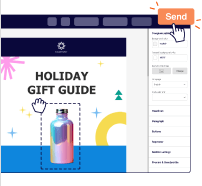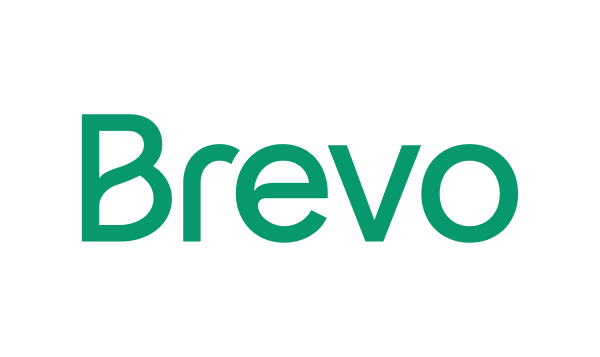Did you know that acquiring a new customer could cost you up to 7x more than retaining an existing one? Okay, you might’ve read that somewhere. But it doesn’t change the fact that retention marketing is making a huge comeback.
Of course, it goes without saying that choosing a robust automated email drip campaign software goes a long way. However, finding one that fits like a glove is harder than it seems. And that’s precisely why I made this drip marketing software comparison guide. Let’s get cracking!
What is an Email Drip Campaign?
An email drip campaign, also called a nurture campaign, is a type of email marketing strategy that involves sending a series of automated emails to a specific segment of your email list.
This is usually triggered by a subscriber’s action or behavior, followed by subsequent emails that aim to educate, entertain, and therefore nurture leads through their buyer’s journey in a conversational tone.
For example, if a user subscribed to get information on a webinar (a trigger), they could get the following drip campaign:
- 1st email: Welcome email for new subscribers with a registration link;
- 2nd email: Reminder a few days before the event;
- 3rd email: Reminder on the day of the event;
- 4th email: Post-webinar email with a link to a recording;
- 5th email: Follow-up email with a survey request;
- 6th email: Follow-up email with a demo invitation.
Here’s another example: a buyer registers for an open house. Kick off real estate drip campaigns with welcome + details, reminders, post-tour follow-up, to start building trust right away through every step of their home search.
While drip campaigns are not the first thing that pops into realtors’ heads when they think about their sales plan, it’s a good example of how drip campaigns can be effectively used outside SaaS and ecommerce.
Key Features of Drip Campaign Software
Want to build customer relationships that actually stick? That’s where drip email campaign software comes in. But how do you choose the right software for your business?
Here are some key features to consider:
- Automated lead segmentation. The best email drip campaign software automatically organizes your audience based on their actions, interests, and engagement levels. This ensures every subscriber receives the right content at the right time;
- Visual drip campaign builder. An intuitive visual workflow builder makes automation easy to design and understand. You should be able to drag, drop, and connect triggers, actions, and conditions without touching a line of code;
- Branching logic. Advanced tools go beyond simple time delays, letting you create dynamic paths based on subscriber behavior. Whether someone opens an email, clicks a link, or makes a purchase, your sequence should adapt automatically;
- A/B testing. To refine your campaigns, look for platforms that allow A/B testing within automation flows. You can test subject lines, email timing, or content to identify what drives the best results;
- Fair pricing. The right software balances powerful automation with accessible pricing. Transparent, scalable plans ensure you only pay for what you need.
Email Drip Campaign Software – Comparison Table
Before I dive into each email drip campaign software in detail, let’s quickly compare them:
| Tool | Best For | Free plan | Price |
| Sender | Best for budget-friendly automation | Yes | From $7/month |
| Omnisend | Best for ecommerce businesses | Yes | From $11/month |
| Drip | Best for ecommerce automation | 14-day free trial only | From $39/month |
| ActiveCampaign | Best for CRM integration | 14-day free trial only | From $15/month |
| Customer.io | Best for real-time, event-driven sequences | 14-day free trial only | From $100/month |
| Brevo | Best for multichannel email + SMS | Yes | From $8/month |
| Kit (ConvertKit) | Best for content creators and digital sellers | Yes | From $33/month |
| HubSpot | Best for marketing + CRM integration | Yes | From $11/month |
| Mailchimp | Best for ready-to-use drip campaigns | Yes | From $13/month |
| SendX | Best for unlimited contact-based pricing | 14-day free trial only | From $8/month |
| Klaviyo | Best for data-driven ecommerce campaigns | Yes | From $20/month |
11 Best Drip Campaign Software Review
Choosing the best email drip campaign messaging software can involve a fair amount of struggle—you have to understand different feature combinations, ease of use considerations, integration capabilities, scalability, pricing, and more!
Here are my best suggestions to help you get started (including my top choice for a free email drip campaign software).
Sender – Most Affordable Email Drip Campaign Tool
Sender offers exceptional value without sacrificing essential features. It combines an intuitive interface with surprisingly advanced capabilities for segmentation, automation, and personalization.
Sender pricing: Starts at $7/month for up to 1,000 subscribers and 12,000 emails/month | Generous Free Plan available.
The platform excels not only at high-performing email marketing campaigns, but also at making complex drip campaigns accessible to businesses with limited budgets.
The drag-and-drop editor makes creating emails straightforward, without needing any coding on your part. You can build professional-looking templates that work across devices without the usual frustration of broken layouts and wonky formatting.
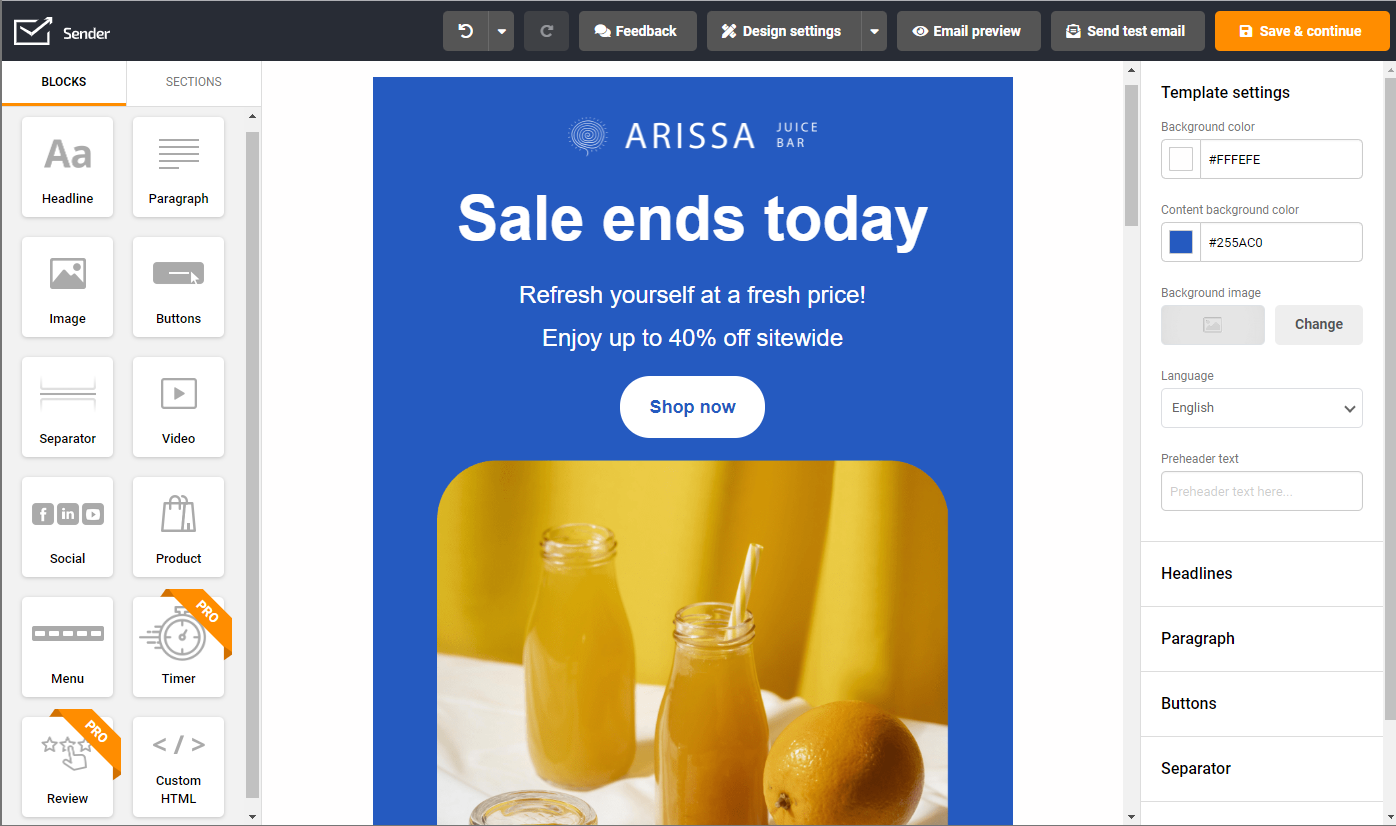
Sender’s segmentation tools are quite impressive. You can slice your audience members into specific groups based on their behaviors, demographics, and engagement patterns.
Meanwhile, the visual workflow builder deserves special mention. It simplifies creating logical branches in your campaigns with an intuitive interface that doesn’t require technical expertise.
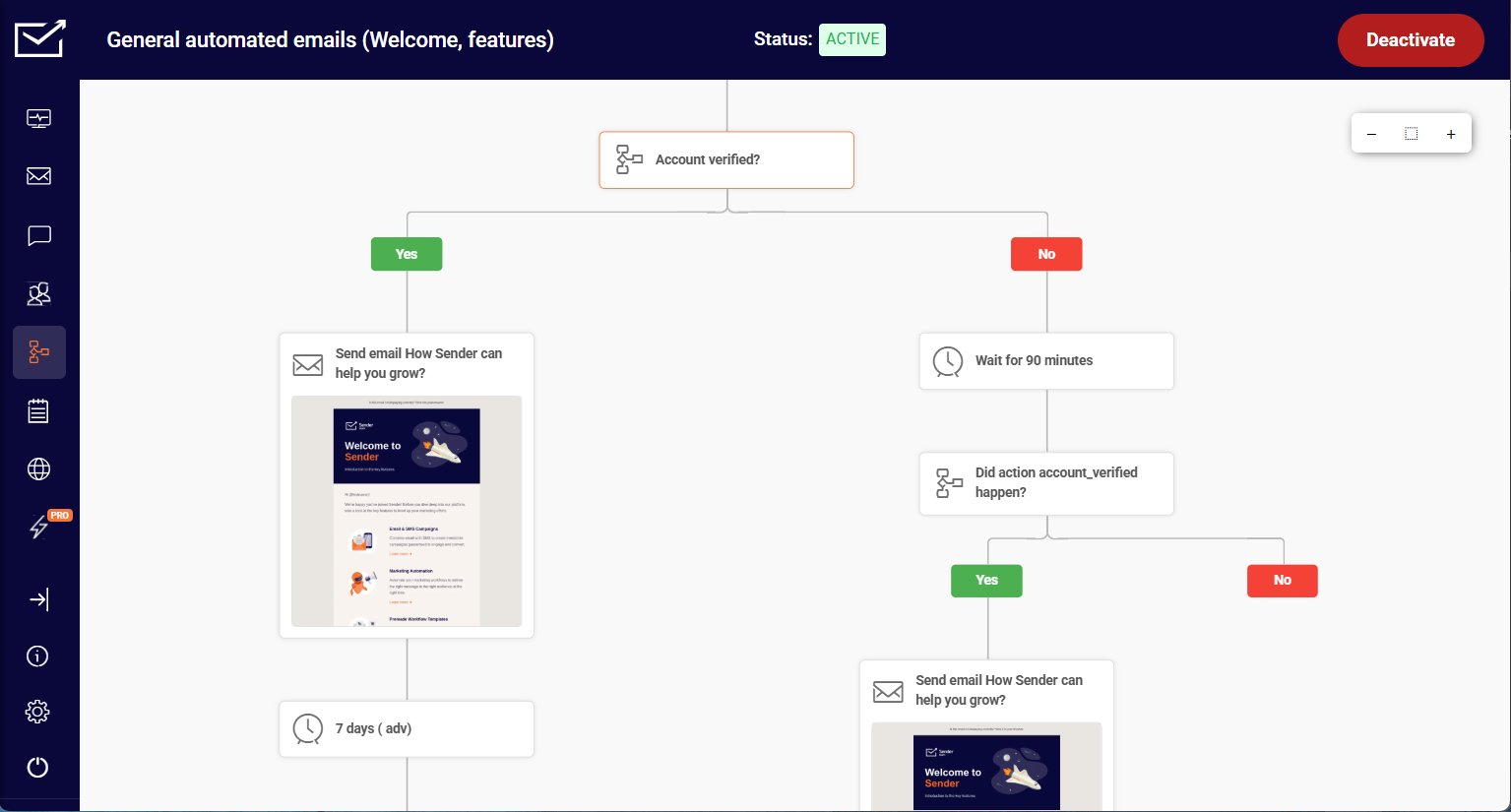
Sender takes email deliverability seriously, too. Their first-class authentication methods help ensure your emails actually reach inboxes instead of vanishing into spam folders, which explains Sender’s impressive 99% deliverability rate.
Key Features
- Budget-friendly premium features. Get advanced segmentation, automation, and analytics at a fraction of competitors’ prices even on the free plan;
- Behavior-based segmentation. Create hyper-targeted audiences based on email engagement, purchase history, and site activity patterns;
- A/B testing in automation. Optimize every step of your workflow by testing different subject lines, email content, or timing within automated email sequences;
- Multiple trigger types. Initiate sequences based on time delays, subscriber actions, or specific events across your marketing ecosystem.
Pros & Cons
Pros:
- Generous free plan. Comes with up to 2,500 subscribers and 15,000 emails per month, giving you access to nearly all premium tools right out of the gate;
- Full automation & segmentation access. Every plan includes powerful automation workflows and advanced audience segmentation features to maximize drip campaign potential;
- Affordable upgrades. As your contact list and marketing needs grow, Sender provides cost-effective upgrade options that unlock additional features without sharp price increases;
- Beginner-friendly. With its intuitive interface and well-designed onboarding process, Sender is an excellent choice for beginners testing the email marketing waters.
Cons:
- Branding on free plan. Emails sent on the free plan display Sender’s logo, which may detract from a fully professional brand appearance.
Best For
Sender bridges the gap between basic free email tools and expensive enterprise platforms, delivering sophisticated automation capabilities at price points accessible to small businesses and startups just beginning their email marketing journey.
- Advanced features available at entry-level pricing tiers where competitors reserve them for premium plans;
- Extensive integrations with CRMs, ecommerce, and analytics tools, plus open API support for effortless data syncing and unified workflows;
- Simpler learning curve than enterprise alternatives while offering comparable segmentation capabilities;
- Complete marketing suite with email, automation, landing pages, and forms in one affordable package.
Pricing
| Plan | Cost | Limitations |
| Free Plan | $0/month | Up to 2,500 contacts and up to 15,000 emails/month |
| Standard Plan | $7/month | Up to 1,000 contacts and up to 30,000 emails/month |
| Professional Plan | $14/month | Up to 1,000 contacts and up to 24,000 emails/month |
See why businesses choose Sender:
Drip – Best Email Marketing Automation Software
Drip specializes in ecommerce-specific automation, turning shopping behaviors into targeted content and marketing opportunities. With ready-made templates for abandoned carts, post-purchase follow-ups, and product recommendations, Drip streamlines the creation of revenue-generating sequences specifically designed for online stores.
Drip pricing: Starts at $39/month for up to 2,500 subscribers | 14-day free trial available.
Drip excels at behavioral segmentation, capturing all those tiny but meaningful shopping actions your customers take. Did they view a product three times? Add something to cart but not purchase? Drip tracks these behaviors and lets you build hyper-targeted segments based on what customers do, not just what they say they want.
The workflow creation feels refreshingly intuitive, too. Want to create a post-purchase upsell flow? That’s just a few clicks away. The platform clearly understands the online shopping journey, which isn’t always true with general-purpose email tools.
Integration with major ecommerce platforms like Shopify and WooCommerce happens smoothly—no technical headaches or missing data fields. According to Drip’s research, businesses using their segmentation features “earn about 5x more revenue than those who don’t”.

Key Features
- Revenue attribution. Track exactly how much revenue each email and campaign generates through detailed conversion reporting;
- Shopping behavior automation. Trigger sequences based on product views, cart additions, purchases, and category browsing patterns;
- Smart product recommendations. Automatically showcase relevant products based on past purchases and browsing history;
- Ecommerce integrations: One-click connections with Shopify, WooCommerce, Magento, and other major platforms. With ready-made templates for abandoned carts, post-purchase follow-ups, and product recommendations.
Pros & Cons
Pros:
- Ecommerce-focused automation. Designed specifically for online stores, Drip turns shopping behaviors into targeted emails like abandoned cart reminders, post-purchase follow-ups, and product recommendations;
- Powerful behavioral segmentation. Tracks key metrics—such as views, clicks, and abandoned carts—to build precise, data-driven audience segments;
- Intuitive workflow builder. The visual editor makes creating complex automation sequences, like upsell or re-engagement flows, quick and straightforward;
- Seamless ecommerce integrations. Works effortlessly with Shopify, WooCommerce, and other major platforms, ensuring smooth data syncing and accurate tracking;
- Proven revenue lift. Drip reports that users leveraging its segmentation tools see up to five times higher revenue from email campaigns.
Cons:
- Higher learning curve for beginners. While powerful, its advanced automation and segmentation tools may feel overwhelming to new users;
- Limited non-ecommerce appeal. The platform’s focus on online retail means service-based or content-driven businesses may find fewer relevant features;
- Pricing can scale quickly. Costs rise as contact lists and automation complexity grow, which might not suit smaller stores on tight budgets.
Best For
While general autoresponder software treats ecommerce as just another use case, Drip was built specifically for online sellers, with specialized features that understand customer shopping behavior and translate it into revenue-generating automation opportunities.
- Ecommerce-specific segmentation that captures micro-interactions most platforms overlook;
- Revenue attribution that directly connects email campaigns to purchases and lifetime value;
- Product recommendation engine that requires no manual setup or constant tweaking;
- Specialized workflow templates designed specifically for common ecommerce scenarios.
Pricing
| Plan | Cost | Limitations |
| 14-day Free Trial | $0/month | Up to 100 contacts and up to 100 email sends |
| Beginner Plan* | $39/month | Up to 2,500 contacts and unlimited emails |
| Professional Plan | $154/month | Up to 10,000 contacts and unlimited emails |
*These are just a few examples of Drip’s current prices—since they no longer offer pre-bundled plans with fixed prices, I’m just showing a couple so you can get an idea of their pricing.
ActiveCampaign – Powerful Multichannel Automation Tool
ActiveCampaign combines robust email marketing with CRM functionality to create a comprehensive automation platform. With over 800 pre-built automation templates and workflows, it drastically reduces setup time while enabling sophisticated campaigns.
The platform’s strength lies in its ability to coordinate marketing and sales efforts through unified customer data, advanced segmentation, and precise targeting across multiple communication channels.
ActiveCampaign pricing: Starts at $15/month for up to 1,000 contacts and up to 10,000 emails/month | 14-day free trial available.
Their segmentation capabilities rank among the best I’ve seen. You can create laser-focused audience slices based on any criteria (behavior, demographics, engagement history), ensuring your drip sequences target exactly the right people.
The visual workflow builder makes complex automation sequences manageable, even with conditional logic and branching paths. For companies with sales teams, the automated lead scoring functionality helps prioritize which leads deserve immediate human follow-up based on their engagement with your drip content.

Key Features
- Predictive sending. AI determines optimal delivery times for each recipient based on past engagement patterns;
- Site tracking integration. Track visitor behavior on your website to trigger perfectly timed follow-up messages;
- Split automation testing: Compare different automation sequences against each other to identify the most effective workflows;
- Machine learning suggestions. Get recommendations for campaign improvements based on performance data analysis.
Pros & Cons
Pros:
- Excellent email deliverability. Messages consistently reach inboxes thanks to reliable infrastructure and strong sender reputation management;
- Flexible automations with conditional logic. Create dynamic workflows that adapt to subscriber behavior for more personalized engagement;
- Extensive integrations. Connect seamlessly with CRMs, eCommerce tools, and other marketing platforms to streamline workflows;
- Precise audience targeting. Use segmentation, tags, and triggers to deliver highly relevant content to each subscriber.
Cons:
- Steep learning curve. The platform’s depth and advanced automation options can feel overwhelming for beginners;
- No actual free plan. Only a limited trial is available before committing to a paid subscription;
Best For
ActiveCampaign stands out by seamlessly bridging the gap between marketing automation and CRM functionality, delivering enterprise-class capabilities at mid-market prices without requiring technical expertise or dedicated system administrators.
- Integrated CRM, marketing automation, and sales automation eliminate the need for multiple disconnected platforms;
- Machine learning capabilities that typically require enterprise budgets are available at much lower price points;
- 800+ pre-built email templates drastically reduce implementation time compared to competitors;
- More sophisticated segmentation options than competing platforms at similar price points.
Pricing
| Plan | Cost | Limitations |
| Starter | $15/month | Up to 1,000 subscribers |
| Plus | $49/month | Up to 1,000 subscribers |
| Professional | $79/month | Up to 1,000 subscribers |
| Enterprise | $145/month | Up to 1,000 subscribers |
Customer.io – Designed for Real-Time, Event-Driven Sequences
Customer.io stands out for its event-based architecture that responds to user actions in real-time rather than relying on predetermined schedules. The flexible data integrations and support for multiple communication channels make it ideal for sophisticated, behavior-driven marketing strategies.
Customer.io pricing: Starts at $100/month for up to 5,000 subscribers & 1,000,000 emails/month.
Customer.io takes a modern approach to drip campaigns. While many platforms rely heavily on time-based sequences, Customer.io builds around an event-based architecture instead, responding to user behaviors as they happen.
The flexible data integrations are also impressive. Their RESTful API email automation and third-party extensions make it simple to pull information from multiple sources. The visual workflow builder handles complex sequences with conditional branching and dynamic personalization in an intuitive way.
Meanwhile, the reporting tool provides clear insights without overwhelming complexity—you get the basic analytics you need to refine your automation strategy without getting drowned in numbers.
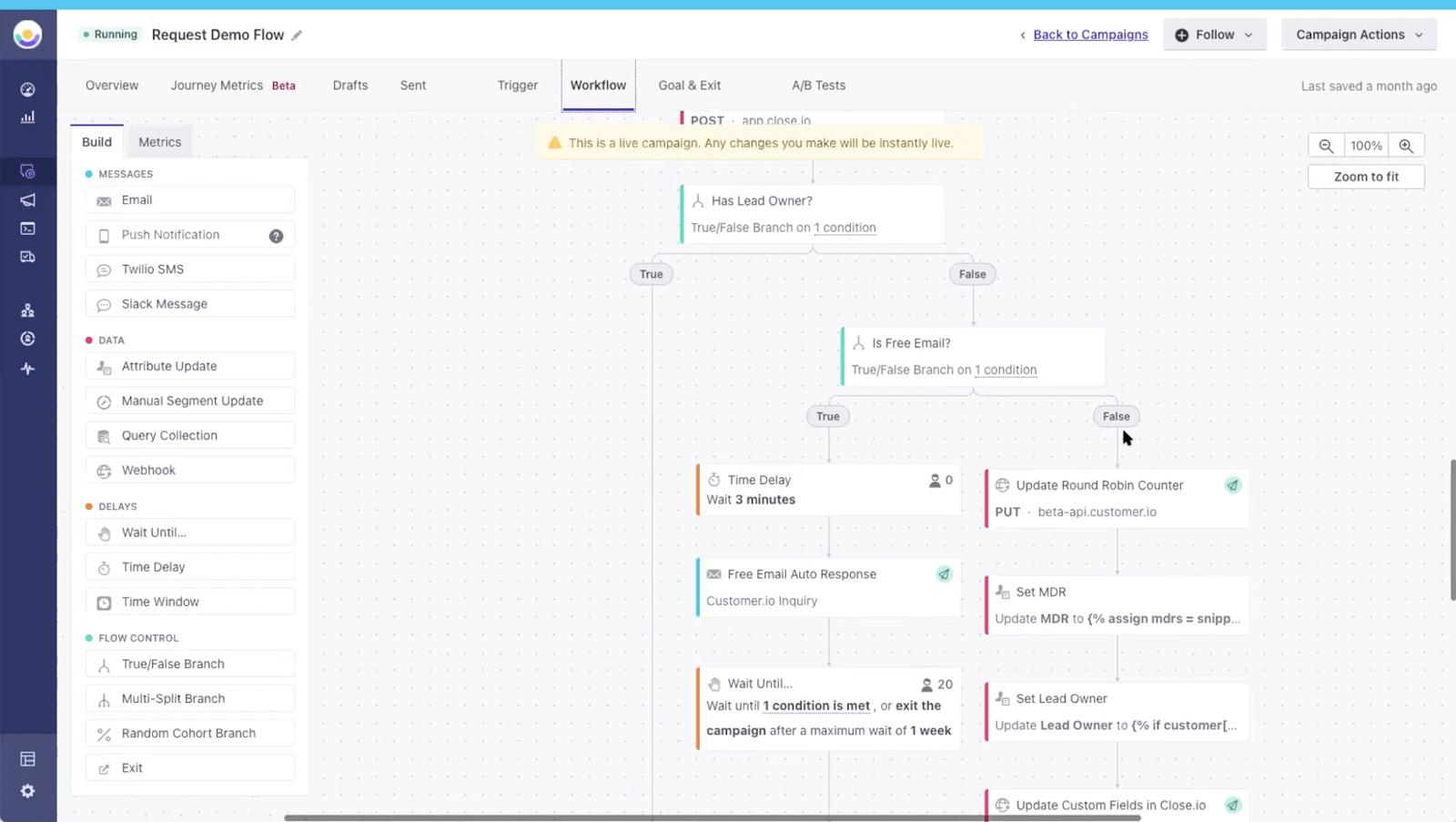
Key Features
- Event-based triggering. Launch messages based on user actions like feature usage, page visits, or interaction milestones;
- Custom conversion metrics. Define what “success” means for each campaign beyond standard open and click-through rates;
- Branching logic workflows. Create sophisticated decision trees that adapt to individual user behaviors and attributes;
- Developer-friendly API. Enable technical teams to push custom events from any digital touchpoint into your campaigns.
Pros & Cons
Pros:
- Event-based automation. Campaigns trigger in real time based on user behavior rather than fixed schedules, allowing for timely, personalized communication;
- Flexible data integrations. RESTful API and third-party extensions make syncing customer data from multiple sources straightforward;
- Clear reporting dashboard. Analytics highlight key performance metrics without unnecessary clutter, making optimization easy;
- Multi-channel support. Coordinate messages across email, SMS, and push notifications from a single platform.
Cons:
- Limited design capabilities. The built-in email editor lacks the polish and flexibility of dedicated template builders;
- Pricing scales quickly. Costs rise as contact volumes and automation complexity increase, which may strain smaller teams.
- Requires technical setup. Implementing events and custom data fields often needs developer support—or coding knowledge.
Best For
Customer.io distinctly outperforms other platforms for SaaS, mobile apps, and digital products by offering a developer-friendly, API-first approach that captures real-time user behaviors and translates them into contextually relevant, perfectly timed messaging.
- True event-based architecture rather than time-based sequences found in most competitors;
- API-first approach more easily integrates with custom tech stacks and product analytics platforms;
- Workflow complexity and conditional logic capabilities surpass what’s available in competing tools;
- Granular tracking and segmentation designed around user behavior within digital products.
Pricing
| Plan | Cost | Limitations |
| Essentials | $100/month | Up to 5,000 contacts and up to 1,000,000 email sends/month |
| Beginner Plan | $1,000/month | Custom contact/email send count |
| Enterprise | Custom price | Custom contact/email send count |
Brevo – Affordable Option with SMS and Email Flows
Brevo delivers multichannel campaign capabilities at price points accessible to any small business. And with intuitive workflow builders and flexible segmentation tools, Brevo makes drip marketing campaigns achievable for growing companies with limited marketing budgets.
Brevo also makes multichannel marketing accessible. From one dashboard, you coordinate automated workflows across email, SMS, and chat messages, creating consistent experiences regardless of which channel your target audience prefers.
Brevo pricing: Starts at $8/month for up to 500 subscribers & 5,000 emails/month | Free plan available
The visual workflow builder welcomes beginners while satisfying experienced marketers. You can design automation sequences with conditional paths based on how recipients interact with your messages.
Their segmentation tools provide numerous targeting options. Create segments using demographic info, engagement history, and custom attributes, ensuring your drip marketing emails reach the right audience with relevant content.
For growing businesses, Brevo scales nicely. Their pricing accommodates increasing subscriber count with minimal contact limits. That said, compared to platforms like HubSpot, Brevo stands out for delivering “scalability at an affordable price.”

Key Features
- Creator-centric design. Purpose-built for selling digital products, courses, and memberships with integrated marketing tools;
- Visual automation builder. Drag-and-drop interface for creating complex subscriber journeys without technical expertise;
- Subscriber tagging system. Organize your audience based on interests, purchase history, and engagement patterns;
- Commerce integration. Sell digital products directly through Brevo without needing separate ecommerce email automation platforms.
Pros & Cons
Pros:
- All-in-one marketing platform. Brevo (formerly Sendinblue) combines email, SMS, chat, and CRM tools under one roof—ideal for managing multiple communication channels in one place;
- Affordable pricing. Its flexible pay-as-you-go and scalable plans make it one of the most budget-friendly options for small to mid-sized businesses;
- Strong automation features. Includes visual workflows for welcome sequences, abandoned cart reminders, and personalized follow-ups without needing coding skills;
- Built-in CRM. Helps track leads, manage contacts, and organize sales pipelines directly inside the platform;
- Reliable deliverability. Consistently high inbox placement rates ensure marketing and transactional emails reach audiences effectively.
Cons:
- Limited template variety. The email template library is smaller compared to competitors like GetResponse or Mailchimp;
- Slow interface at times. Some users report lag when editing emails or navigating large contact lists;
- Basic analytics on lower tiers. Deeper reporting and A/B testing features are reserved for higher-priced plans;
- SMS credits sold separately. SMS marketing costs extra and can add up quickly for frequent senders.
Best For
Brevo delivers multichannel marketing capabilities that typically require enterprise budgets but packages them at price points accessible to small businesses, with particular strength in combining email and SMS campaigns within unified automation workflows.
- Email and SMS marketing, managed from a single interface, where most competitors require separate platforms;
- More generous sending volumes at each price tier compared to similar platforms;
- Stronger transactional email capabilities than most marketing-focused automation tools;
- CRM integration is included without the steep learning curve of enterprise platforms.
Pricing
| Plan | Cost | Limitations |
| Free | $0/month | Unlimited contacts and up to 300 emails per day; |
| Starter | $8/month | Unlimited contacts and up to 5,000 emails per month; |
| Business | $16/month | Unlimited contacts and up to 5,000 emails per month + marketing automation features |
| Professional | $449/month | Unlimited contacts and from 150,000 emails per month + advanced marketing automation features |
Kit – Creator-Focused Email Campaigns Builder
Kit (formerly ConvertKit) specializes in serving content creators, course builders, and digital product sellers with straightforward yet powerful automation tools.
Kit pricing: Starts at $33/month for up to 1,000 subscribers | Free plan available
The platform strips away unnecessary complexity while preserving essential functionality, making it particularly suitable for non-technical users who need professional email marketing capabilities.
I also loved their two-pronged approach to drip campaigns. “Sequences” create simple, linear email series (perfect for straightforward courses or welcome campaigns); while “Automations” enable complex, branching workflows responding to subscriber actions. This tiered approach welcomes email marketing beginners, but provides room to grow as your marketing sophistication increases.
The tagging system organizes subscribers effectively without the complexity found in some enterprise solutions. Meanwhile, the creator-focused tools for selling digital products, courses, and memberships also shine.
Kit also offers a free Newsletter plan with basic analytics for those just getting started. Their email builder makes creating professional-looking campaigns simple, even for those without much design experience.
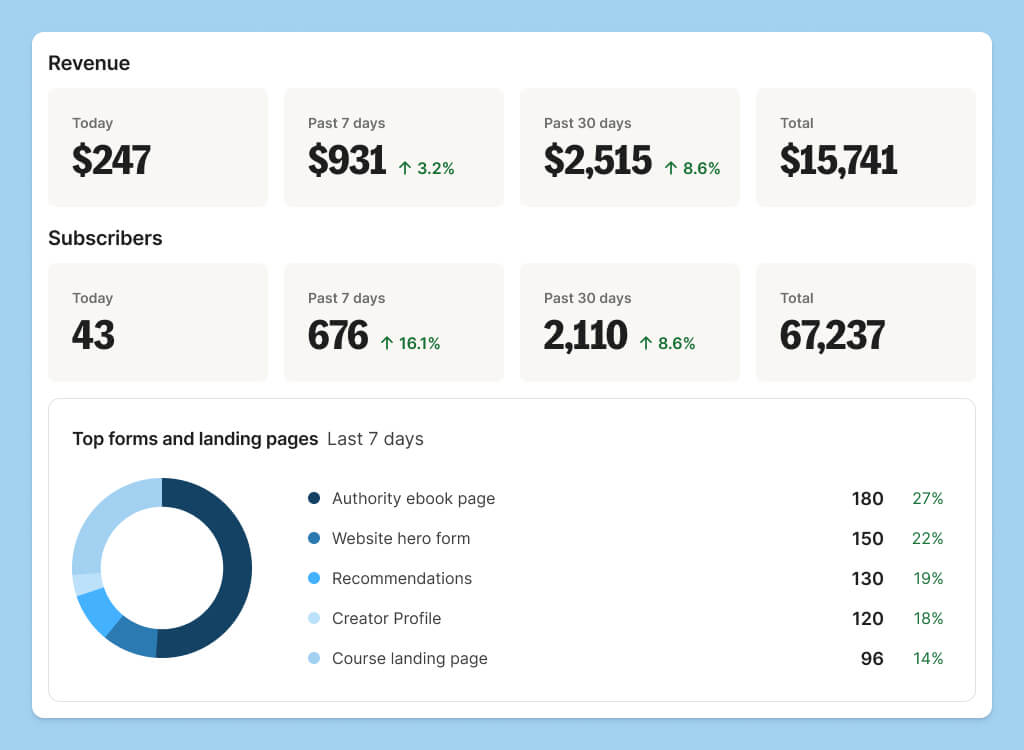
Key Features
- Creator-centric design. Intuitive interface and tools designed specifically for content creators to easily build and send engaging emails;
- Visual automation builder. Drag-and-drop interface to effortlessly create complex drip email sequences and automate your marketing workflows;
- Subscriber tagging system. Organize your audience into specific segments based on demographics, interests, or behavior for highly targeted campaigns;
- Commerce integration. Connect your online store to seamlessly sync customer data, personalize emails, and drive sales through automated campaigns.
Pros & Cons
Pros:
- User-friendly builder. The drag-and-drop editor is intuitive and requires no coding skills, making email creation simple for beginners;
- Wide template selection. A rich library of pre-designed templates helps you craft polished emails and newsletters quickly;
- RSS campaigns. Automatically turn new website content into newsletters with RSS-to-email automation;
- Advanced segmentation. Personalize campaigns easily for different audience segments using dynamic content.
Cons:
- No spam or inbox previews. Lacks built-in tools to check spam triggers or preview emails across clients;
- Limited free plan. The free version offers only basic features, with most advanced tools locked behind paid tiers;
- Slow support. Response times can be sluggish, especially for users on free or entry-level paid plans.
Best For
While general marketing platforms try to serve everyone, Kit focuses exclusively on content creators and course sellers, providing specialized features designed specifically for digital products, memberships, and audience monetization.
- Purpose-built for creators, not retrofitted from business-oriented marketing tools;
- More intuitive product selling features without requiring separate ecommerce platforms;
- Simplified workflow creation that doesn’t sacrifice advanced capabilities;
- Creator-centric pricing model that scales more reasonably with audience growth.
Pricing
| Plan | Cost | Limitations |
| Newsletter | $0/month | Up to 10,000 subscribers and 1 basic visual automation |
| Creator | $33/month | Up to 1,000 subscribers and unlimited emails |
| Creator Pro | $66/month | Up to 1,000 subscribers and unlimited emails |
HubSpot – CRM with Customer Relationships Focus
HubSpot integrates comprehensive marketing automation with robust CRM capabilities, creating a unified platform for customer communication. The native connection between marketing and sales data enables highly personalized drip campaigns based on detailed contact records and interactions.
HubSpot pricing: Starts at $11/month for up to 1,000 contacts and up to 5,000 emails/month | Free plan available.
The main benefit of HubSpot’s approach is the connection between marketing automation and CRM data. This native integration simplifies email personalization based on detailed contact records, yielding higher conversion rates through more consistent communication.
During my time with HubSpot, I couldn’t help but notice how user-friendly their workflow editor is. It also comes with premade drip campaign templates that save significant setup time.
For businesses implementing comprehensive inbound marketing strategies, HubSpot offers integrated tools for content management, social media, landing pages, and forms—all triggering or supporting drip campaign sequences.
The built-in CRM with email automation and drip campaign functionality in HubSpot works particularly well, allowing agents to nurture new leads over the long timeframes typical in property sales.
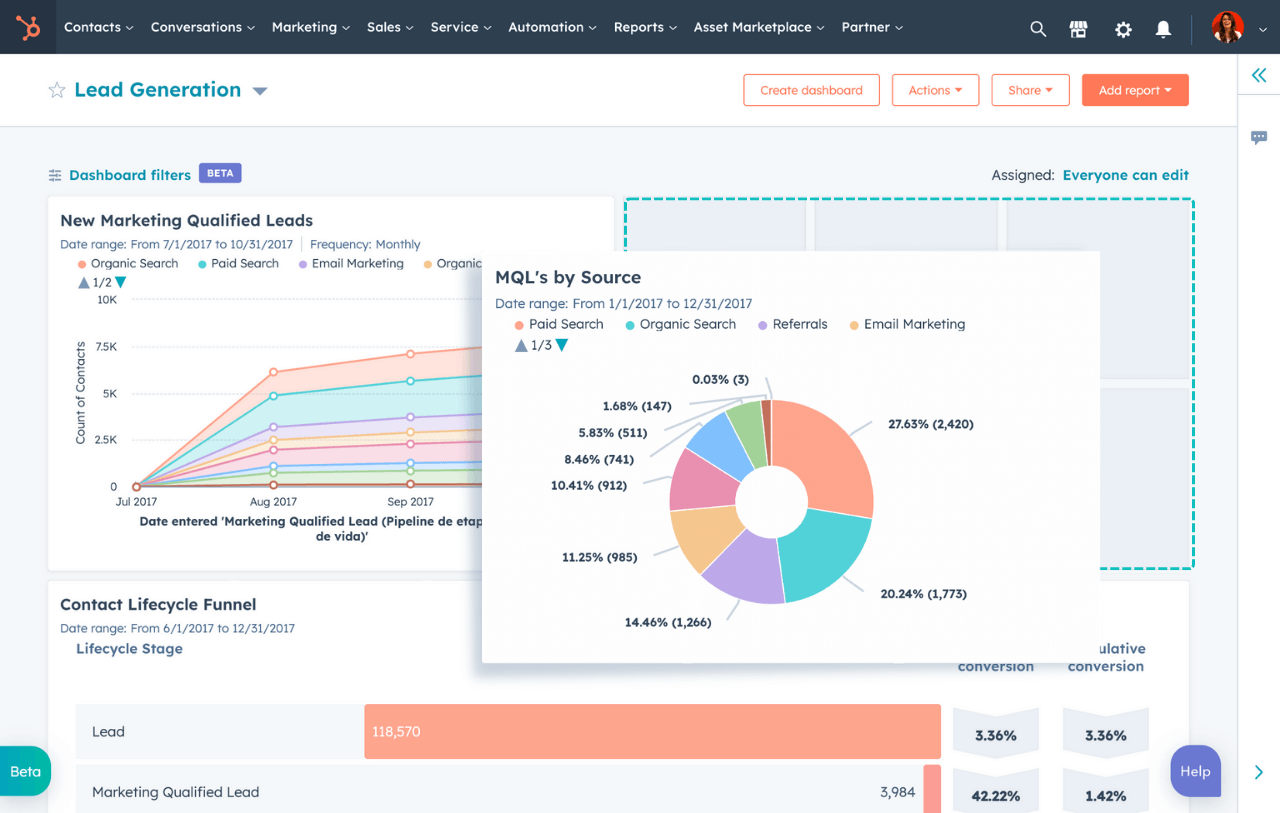
Key Features
- Smart content personalization. Dynamically adapt email content based on recipient properties, behaviors, and list memberships;
- Integrated marketing tools. Connect email campaigns seamlessly with blogs, social media, ads, and website content;
- Progressive profiling. Gradually collect more contact information through forms that adapt to what you already know;
- Campaign ROI analysis. Track complete attribution from first touch to final conversion across all marketing channels.
Pros & Cons
Pros:
- Excellent deliverability. Transactional and marketing emails reliably reach inboxes on time, reducing bounce rates and delivery issues;
- Developer-friendly API. Well-documented and easy-to-use APIs make integration smooth and efficient for developers;
- Responsive support. Offers fast, knowledgeable customer service to resolve issues and enhance email performance;
- Quality templates. Provides a solid range of customizable, professional templates to streamline design and ensure brand consistency.
Cons:
- No built-in CRM. Lacks native CRM tools, so advanced contact tracking requires third-party integrations;
- Higher per-email cost. Pricing is steeper than most bulk senders, making it less suitable for high-volume campaigns;
- Limited marketing tools. Prioritizes transactional email delivery over marketing automation, segmentation, or campaign management.
Best For
HubSpot stands alone by fully integrating marketing, sales, and service tools in one platform, eliminating the fragmentation and data silos that plague businesses using separate systems for different customer-facing departments.
- Complete integration between marketing, sales, and service platforms that competitors can’t match;
- Consolidated customer data, providing true 360-degree views impossible with disconnected systems;
- Sophisticated attribution reporting across the entire customer journey from first touch to renewal;
- Seamless handoffs between marketing and sales teams that eliminate common conversion friction points.
Pricing
| Plan | Cost | Limitations |
| Free | $0 per month | Up to 2,000 email sends per month. HubSpot’s branding with emails. No marketing automation features. |
| Starter | $10 per month | Up to 1,000 subscribers and 5x tier contact limit for email sends |
| Professional | $928 per month | Up to 2,000 subscribers and 10x tier contact limit for email sends |
Mailchimp – Ready-to-Use Drip Email Platform
Mailchimp is a veteran email marketing platform that balances sophisticated automation capabilities with a user-friendly design. The platform features an extensive template library, an intuitive customer journey builder, and a comprehensive analytics suite.
Mailchimp pricing: Starts at $13/month for up to 500 contacts and up to 10,000 emails/month | Free plan available.
Mailchimp’s template library contains over 130 professionally designed email templates easily customizable for different drip scenarios. Whether you need a welcome series, abandoned cart automation, or post-purchase follow-up, Mailchimp has ready-to-use designs that save hours of work.
Their customer journey builder provides an intuitive visual interface for creating automated email sequences. Trigger these based on specific user actions or schedule them based on time intervals, giving flexibility in how you structure campaigns. Meanwhile, the subject line tester helps optimize your emails for higher open rates.
The analytics dashboard shows comprehensive insights into opens, clicks, and other key metrics that matter to your campaign’s success. This helps identify which sequences perform well and which need optimization, providing valuable insights to guide future campaigns.
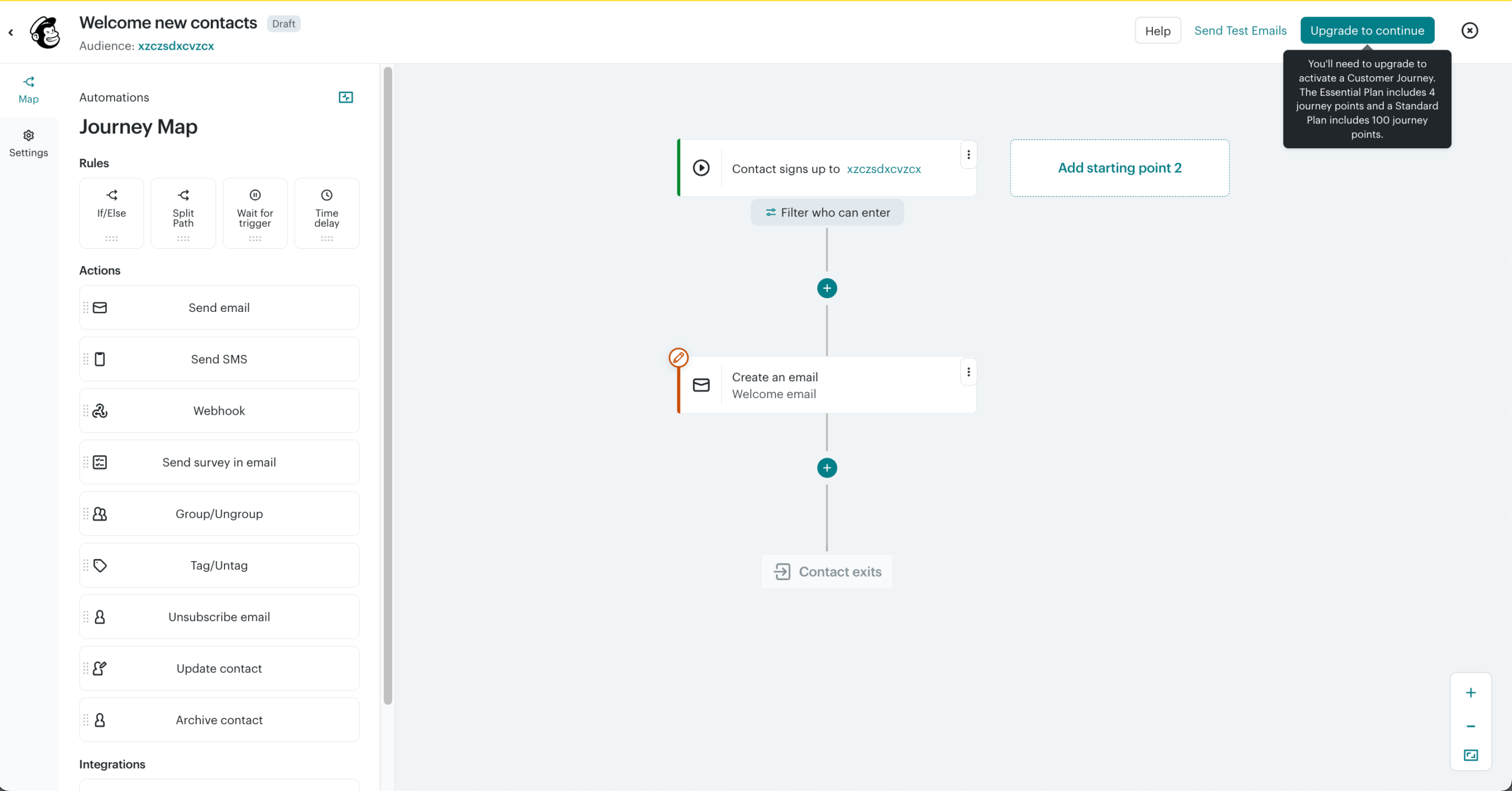
Key Features
- Journey mapping visual builder. Create multi-step campaigns with an intuitive drag-and-drop canvas interface;
- Content recommendation algorithm. Automatically suggest products based on purchase history and browsing behavior;
- Send-time optimization. Schedule delivery when recipients are most likely to engage based on past activity;
- Behavioral targeting segments. Create dynamic audience segments that update automatically as subscribers take actions.
Pros & Cons
Pros:
- User-friendly. Mailchimp features a clean interface and helpful setup guides, making it easy for beginners to get started;
- Predictive analytics. Leverage behavioral data to forecast subscriber actions, improve targeting accuracy, optimizing campaign performance with data-driven insights;
- Extensive integrations. This marketing solution offers seamless integration with a wide range of platforms, including Shopify, WordPress, and various CRMs.
Cons:
- Clunky form builder. The signup form tool isn’t the most intuitive and can be difficult to customize or embed effectively;
- Slow and limited support. Customer support can be sluggish, particularly for free users, making troubleshooting more difficult.
Best For
Mailchimp balances sophisticated features with unmatched usability, making advanced marketing automation accessible to non-technical users while providing scalability to grow from solopreneurs to enterprises without platform migrations.
- Intuitive template editor that produces consistently responsive designs without technical knowledge;
- Strong ecommerce functionality without requiring the complexity of dedicated ecommerce platforms;
- Superior mobile app for campaign management compared to most competitors’ mobile experiences.
Pricing
| Plan | Cost | Limitations |
| Free | $0/month | Up to 500 subscribers and 1,000 emails/month |
| Essentials | $13/month | Up to 500 subscribers and 5,000 emails/month |
| Standard | $21/month | Up to 500 subscribers and 6,000 emails/month |
| Premium | $302/month | 10,000 subscribers and 150,000 emails/month |
SendX – Tag-Based Email Campaigns Software
SendX combines advanced automation capabilities with an interface accessible to non-technical users. What makes this drip marketing software stand out is its smart tagging system—it tracks what your subscribers do and sends follow-up emails tailored to their actions.
SendX pricing: Starts at $8/month for up to 1,000 contacts | Free plan available.
With geolocation-based scheduling, unlimited contacts, and an intuitive visual builder, SendX delivers dynamic drip campaigns without the head-spinning complexity that comes with enterprise marketing platforms.
Their visual drag-and-drop email builder also feels genuinely user-friendly, and with pre-built templates speeding up campaign setup considerably, I was able to set up an entire campaign in under 20 minutes.
Another standout feature of SendX is its powerful segmentation. It made it super easy for me to target specific audiences with pinpoint accuracy using demographics, behavior, and custom tags.
Finally, the A/B split testing functionality lets you experiment with different email elements (subject lines, content, send times) to identify what generates the best response.
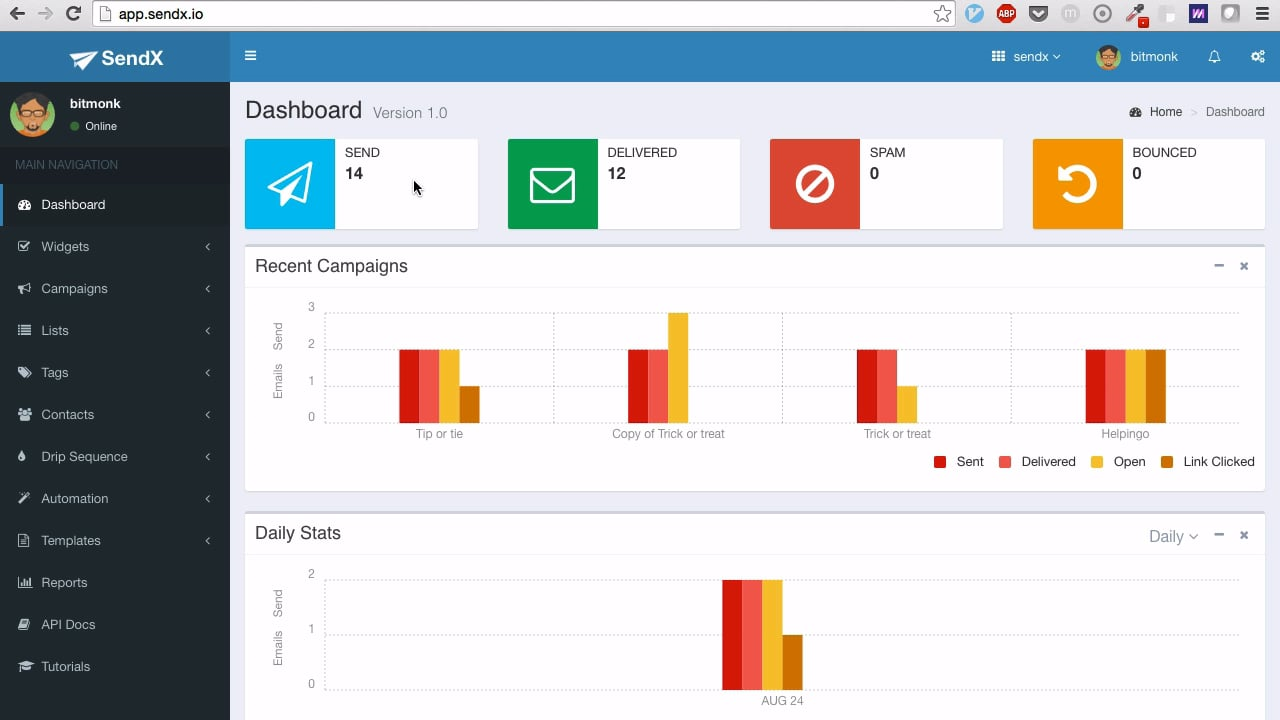
Key Features
- Visual rule-based automation. Effortlessly trigger actions using tags, link clicks, or form submissions through an intuitive visual interface;
- Reusable snippets and templates. Build branded content blocks once and reuse them across emails, sequences, and broadcasts for consistent, time-saving messaging;
- Streamlined segmentation tools. Use tag-based segmentation to launch highly targeted campaigns for product releases, downloads, or community updates;
- Built-in creator network. Tap into a ready-made creator ecosystem to cross-promote your offers and expand your subscriber base.
Pros & Cons
Pros:
- Simple, intuitive interface. SendX is easy to navigate, making it ideal for beginners who want to launch campaigns quickly without technical know-how;
- Strong automation tools. Offers visual workflows for drip campaigns, tagging, and behavior-based triggers to personalize outreach;
- Excellent deliverability. Consistently achieves high inbox placement rates thanks to built-in optimization and list hygiene tools;
- Responsive customer support. Known for fast, helpful support through chat and email, even for lower-tier users.
Cons:
- Basic design customization. The template editor, while functional, lacks some of the advanced styling flexibility offered by larger platforms;
- Limited integrations. Works with popular tools but doesn’t have as many native integrations as competitors like GetResponse or ActiveCampaign;
- No free plan. Only offers a short trial, so ongoing use requires a paid subscription.
Best For
SendX disrupts the standard email marketing pricing model by offering unlimited contacts across all plans, making it uniquely affordable for businesses with large subscriber databases that send relatively infrequent campaigns.
- Unlimited contacts pricing model, unlike competitors who charge primarily based on list size;
- Advanced features, available at lower price tiers than competing platforms;
- Simplified user interface without sacrificing advanced segmentation capabilities;
- Stronger deliverability focus at lower price points than many competitors offer.
Pricing
| Plan | Cost | Limitations |
| Free 14-day Trial | $0/month | Up to 500 subscribers and 2,000 emails/month |
| Base Plan | $8/month | Up to 1,000 subscribers and unlimited emails |
| SendX Plus | Base plan price + $500/month | 25,000 subscribers and unlimited emails |
Klaviyo – Data-Driven Email Automation for Ecommerce
Klaviyo takes ecommerce drip campaigns to another level with its unmatched data-driven approach.
Klaviyo pricing: Starts at $20/month for up to 500 contacts | Free plan available.
During my hands-on with it, what stood out most was how effortlessly it synced with Shopify and WooCommerce. Every product view, cart action, or purchase can trigger tailored messages that drive real revenue.
The workflow builder feels intuitive despite Klaviyo’s sophistication. You can easily combine email and SMS into a single flow and visualize customer journeys without technical hurdles. I enjoyed how the analytics go beyond opens and clicks—you can see exactly how much revenue is generated by each campaign.
While its pricing leans toward the higher side, Klaviyo justifies it with exceptional segmentation, dynamic product recommendations, and seamless ecommerce integrations that make it one of the smartest tools for online stores serious about automation and retention.
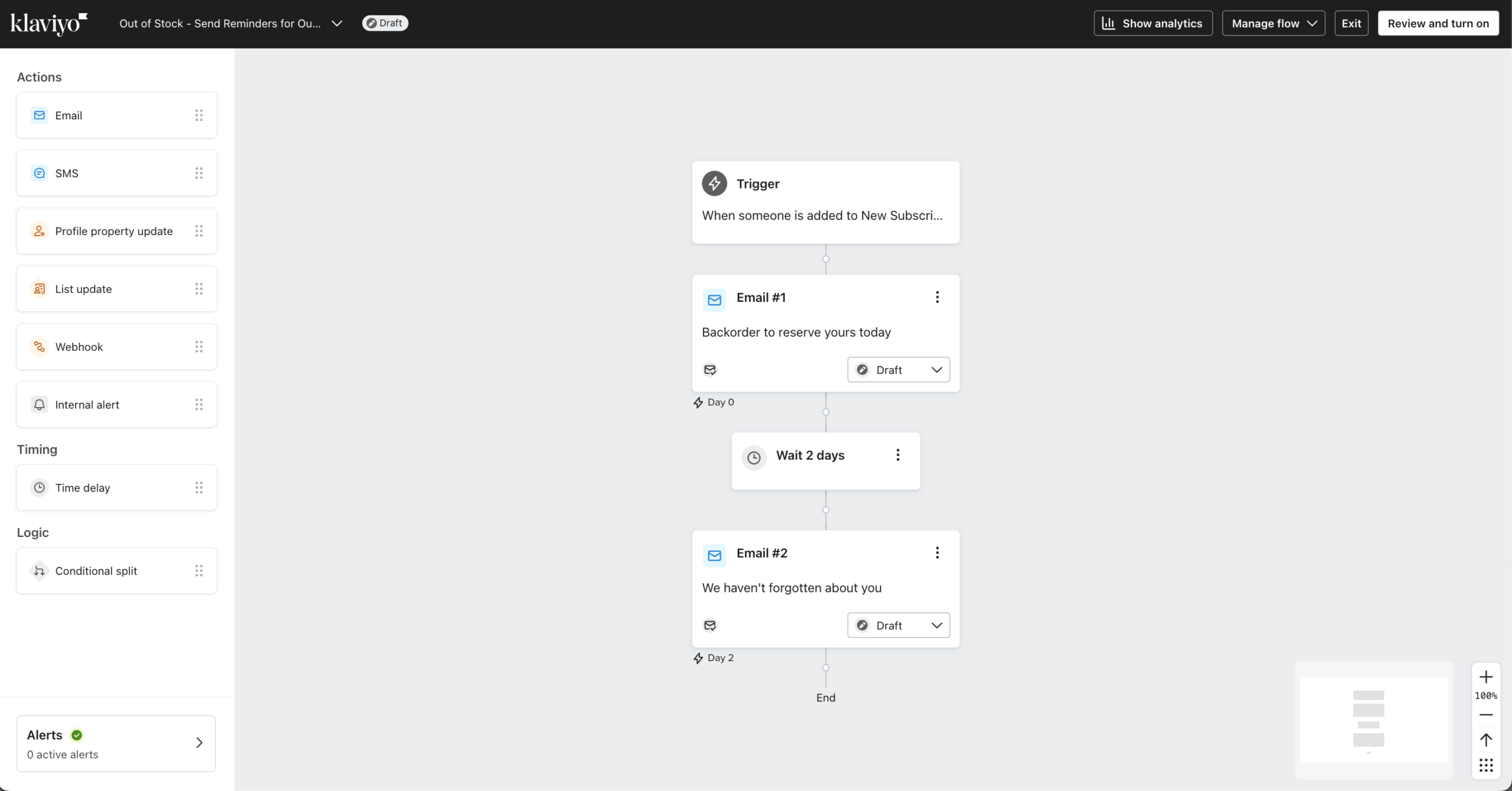
Key Features
- Ecommerce-grade personalization. Tailor every email using customer behavior, browsing history, and purchase data;
- Advanced segmentation. Build precise segments using real-time data for targeted messaging;
- Email + SMS automation. Manage multichannel campaigns within a single workflow.
- Revenue reporting. Track sales performance directly tied to each campaign and automation flow;
- Dynamic content. Personalize emails automatically with recommended products, recent views, and predictive analytics.
Pros & Cons
Pros:
- Deep ecommerce integrations. Integrates smoothly with Shopify, WooCommerce, and BigCommerce, enabling real-time customer data syncs that fuel high-converting WooCommerce drip campaigns;
- Powerful personalization. Uses real-time behavioral data to send hyper-relevant messages that boost engagement and sales.
- Revenue-focused analytics. Tracks how much each campaign and automation flow contributes to total store revenue;
- Multichannel automation. Combines email and SMS sequences seamlessly for unified customer journeys;
- Scalable for growth. Handles small shops and large enterprises alike with flexible automation and segmentation tools.
Cons:
- Steeper learning curve. The advanced data tools can feel overwhelming for beginners or those used to simpler platforms;
- Premium pricing. More expensive than entry-level tools, especially as contact lists expand;
- Limited value outside ecommerce. Best suited for online stores — service-based businesses may find its feature set excessive.
Best For
Klaviyo is ideal for ecommerce businesses ready to scale their email automation with serious data power. It excels at turning customer behavior into revenue-driven drip campaigns that feel genuinely personal. If you rely on Shopify or WooCommerce and want to squeeze more value from every purchase, Klaviyo’s predictive insights and detailed reporting make it an easy top-tier choice.
Pricing
| Plan | Cost | Limitations |
| Free | $0/month | Up to 250 contacts and 500 email sends |
| Email Plan | From $20/month | 5,000 email sends/month, includes core drip campaigns |
| Email & SMS Plan | From $20/month | Includes both channels, advanced reporting, and 150 mobile messaging credits/month |
Why Trust Our Email Drip Campaign Recommendations
In writing this guide, each drip campaign went through a hands-on evaluation. With each platform, I had set up real workflows, measured their deliverability, tested automation logic, and assessed ease of use.
Key evaluation criteria include:
- Automation flexibility;
- Segmentation & personalization options;
- Email design tools;
- Deliverability rates;
- Integrations;
- Pricing transparency.
This deep-dive testing approach means my recommendations aren’t just lucky guesses—they’re reliable, evidence-based and ready to help you find drip tools that will make a difference.
Email Drip Campaigns Software FAQs
How effective are email drip campaigns?
Email drip campaigns are highly effective for lead nurturing and boosting conversions. Studies show drip campaigns can generate up to 80% more sales at a 33% lower cost than standard email blasts. Combined with personalized content and strategic timing, email drip campaigns are one of the most efficient methods to drive engagement, strengthen relationships, and improve overall ROI.
What’s the difference between drip campaigns and email automation?
All drip campaigns are automated, but not all automated emails are drip campaigns. Also, instead of sending everything in one direct mail campaign, drip campaigns are designed to share information in snippets, shared via multiple emails, over a period of time. Whereas automation reacts dynamically to user behavior in real time.
Do I need technical skills to set up drip campaigns?
No, you don’t need to be a tech-wiz to set up a drip campaign. Most modern email marketing services like Sender offer intuitive drag-and-drop builders that let you design and automate drip campaigns without touching a line of code. These tools handle scheduling, segmentation, and triggers through simple visual workflows.
How much does drip campaign software cost?
The cost of drip campaign software varies based on its features, contact or email limits, and level of support. For example, Sender starts at just $7 per month, making it an affordable option for smaller drip campaigns. Meanwhile, platforms like Drip begin at $39 per month, offering more sophisticated targeting but a less appealing price tag.
